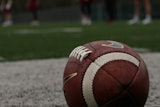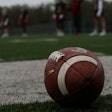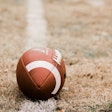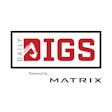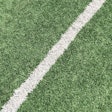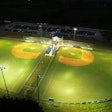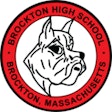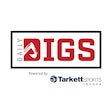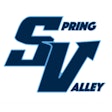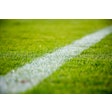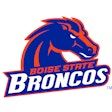A majority of NCAA Division I-A programs now play football on synthetic turf, but natural surfaces still thrive among the nation's elites.
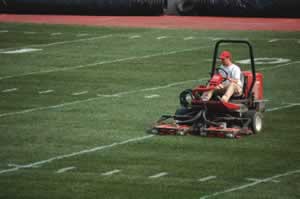
As Tressel spoke, crews were busy removing Ohio Stadium's weathered surface, a four-year-old hybrid system of natural grass and synthetic root-zone stabilizers, so that $75,000 worth of new sod could be installed for the Buckeyes' next home game Oct. 7. It was the first time in the 16-year stretch that Ohio State has been playing on natural grass that a field required mid-season replacement. And for the first time in a long time, university administrators began taking a second look at synthetic turf as a viable surfacing option. "The roll-cut sod is as good as you get as far as stability for now, but there is a lot to think about and evaluate," says Don Patko, Ohio State's assistant athletic director for facilities management. "We'll see how this one plays, then look at some other fields - grass and synthetic - and mull it over. We're going to make a decision at the end of the year."
For the third time in 13 years, Athletic Business has evaluated both types of playing surfaces in terms of their popularity among decision makers at all Division I-A schools. Our results indicate that the kind of mulling now taking place in Columbus has been widespread since the 1999 AB survey, which found natural grass to be the clear-cut favorite - 73 fields to 35 (plus four grass/synthetic hybrids) - among the 112 schools then competing at college football's highest level (see "Grass Gets Greener," Sept. 1999, p. 39). If the hybrids are added to the grass category, as such fields are in our 2006 survey, the 1999 results become even more one-sided. Regardless, those numbers represented a tremendous growth spurt for grass over the previous six years, a period in which 20 schools switched from synthetic to natural surfaces while only two made the opposite switch. The initial AB survey, conducted in 1993, found 55 schools playing their home games on grass, 50 playing on synthetic turf, and one - the University of Alabama - hosting games on both (see "Survey Says," Sept. 1993, p. 33).
Today, the reemergence of synthetic turf - in the form of infill systems, specifically - has effectively uprooted any hope among purists of a natural grass monopoly, at least in the near future. In fact, synthetic-turf installations taking place this year at Alabama-Birmingham, Arkansas State, Colorado State, Louisiana Tech and Wake Forest have swung the Division I-A majority in favor of synthetics - and not by a monofilament-thin margin, either. Sixty-two teams now tee it up with polyethylene and crumb rubber underfoot, while 57 schools still prefer to grind it out on grass. "It's a commitment," Patko says of caring for a grass surface. "After a football game, I have three agronomists and a staff of students plugging, sanding, seeding and fertilizing to get the field ready for the next week. You're talking about a living thing, and when you have 300-pound people going at each other on it, something's got to give."
Ohio State is hardly alone in making the commitment - for now, anyway - to natural grass, particularly among the nation's elite football programs. Of the 65 schools competing as members of the six Bowl Championship Series conferences, 40 still favor grass on their game fields. Moreover, 18 schools in the Associated Press preseason top 25 ranking - including eight among the top 10 - play on grass. "The BCS schools are putting more money and knowledge into their athletic fields than the other schools, so they're able to maintain that natural turf at a higher level," explains Andy McNitt, associate professor of soil science at Penn State University, where football has always been played on grass. "I think part of the problem facing natural grass in this country is a lack of budget dollars and a lack of knowledge about how to take care of it. You need both. You need some money and you need some expertise."
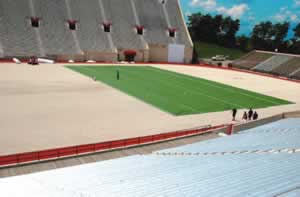
Grass remains particularly popular in conferences that stretch into southern states. In the 12-team Southeastern Conference, only Ole Miss plays on synthetic turf. Among the dozen teams of the Atlantic Coast Conference, Boston College and Wake Forest claim the only stadiums with synthetic installations. "One of the reasons you don't see synthetic turf coming back in the south as much as it has in other regions is temperature," says Bob Campbell, director of sport surface management at the University of Tennessee. "If you have a game down here in early September and it's 90 degrees, it's going to be awfully hot on a synthetic surface."
Heat is one of two drawbacks to the new-generation synthetic turf systems that Penn State's McNitt has identified in his ongoing eight-year research project comparing a variety of infill brands. The other is abrasiveness. Today's long-stranded synthetics are half as abrasive as the short-pile nylon carpets of the 1960s, '70s and '80s, McNitt says, but they're still more abrasive than natural grass.
That said, the self-described "natural grass person" is quick to point out several positives that today's synthetics offer, and wear tolerance tops McNitt's list. Using a mechanical device designed to simulate football wear, "we were wearing some of these fields at a rate equivalent to eight NFL games a week, which we know natural turf will not take," McNitt says. "So at extreme levels of use, you don't have much choice other than synthetic turf."
Moreover, after a year's worth of simulated wear, synthetic fields exhibit greater consistency of playability - as measured in terms of rotational and linear traction, abrasiveness and overall resilience - across the entire span of the surface than do heavily used natural grass fields, which tend to exhibit greater wear down the center of the field than outside the hash marks. The latter scenario could equate to unsure footing for athletes, according to McNitt, who adds, "Some data indicate that variability could increase a player's chance of a non-contact lower-extremity injury." (While McNitt's work doesn't directly address injury risks, the NCAA Injury Surveillance System this year modified its ongoing collection of surface-related injury data to address such details as the specific brand and age of infill synthetic systems, and the species type and mowing height of natural grass fields.)
In August, McNitt released research findings that effectively debunk the common notion among athletic trainers and coaches that synthetic turf can serve as a breeding ground for Staphylococcus aureus bacterium. In fact, McNitt found no trace of staph in any of 20 fields he tested. "Bacterial levels on these fields were lower than what we find on natural grass," he says.
Finally, McNitt's eight-year study also takes into account how infill synthetic turf systems respond to regular maintenance. "You do need to take care of these fields," he says. "The difference is it's kind of brainless. You can recipe it. You can say, 'On this day do this, and on this day do that.' Because it's not a living system, it doesn't need to be managed the way a living system does."
But the maintenance differences don't end there. The latest AB survey results indicate that schools with grass football fields average roughly $57,000 in annual maintenance costs, whereas schools with synthetic turf in their stadiums spend about $16,000. Factor in what those investments yield in terms of field usage, and the synthetics stand even taller. Schools that play on grass report using their field an average 29 days out of the year, while schools with synthetics get an average 143 days of annual use. That's a difference of $1,855 spent on maintenance per usage day.
Getting the most out of maintenance resources was one reason Colorado State University, located in Fort Collins, installed synthetic turf this summer. "Our part of the state has been in a drought for the past five years, and we have a hard time just maintaining some of our practice fields at the level they need to be maintained," says Doug Max, the university's associate athletic director for facilities and scheduling, adding that the decision to install a synthetic field came down to two factors: practicality and personal preference. "One of the things that the university looked at was the cost savings of water. Plus, our team played on the new synthetic fields and liked them."
Max also anticipates that more events will be scheduled on the synthetic field in coming years. "Hughes Stadium has basically been just a football venue," he says. "But now the synthetic field offers a lot more opportunity for involvement of the soccer and lacrosse teams, as well as concerts and those types of events."
As past president of the Sports Turf Managers Association, Tennessee's Campbell concedes that today's synthetics make a lot of sense for a lot of schools. "As a traditionalist, I enjoy growing grass and everything that goes with it, but I understand the synthetic turf situation, too," he says. "If you have to do it, you have to do it. And there's no doubt that the new synthetics are far superior to the old synthetic turf that was out there."
The swing in the preference pendulum may also reflect fallout caused by well-documented failures over the past several years of sand-based natural grass fields. "The turfgrass industry promised more than it could deliver," Campbell says. "Sometimes those fields were put in stadiums where it didn't matter what people did, the fields were going to have trouble because of the amount of activity on them. That's the one drawback of natural grass. It will not take unlimited play."
Even at Purdue University - the birthplace of sand-based, synthetic-reinforced Prescription Athletic Turf - athletics officials including head football coach Joe Tiller were forced to scout alternatives when the PAT in Ross-Ade Stadium underperformed last season in the face of unusually high soil temperatures. In the end, Purdue chose a cold-tolerant strain of Bermuda grass over synthetic turf, and the Boilermakers won their first four games of the 2006 season on it. Says Tiller, "I don't know how much of that is a credit to the field, but it's a non-issue now, which is what we want."
Natural grass continues to survive through good times and bad, cultivated by a growing number of turfgrass departments at major research universities. Michigan State, for one, bucked the recent surface preference trend by replacing the synthetic field at Spartan Stadium with natural grass in 2002. "The mind-set was that we have a turfgrass program here that's one of the best in the world," says Greg Ianni, MSU's senior associate athletic director for facilities and sports management. "We wanted to put our technology in the stadium, because it was a little bit difficult for the university to sell its technology to the world when we didn't even use it here."
Ianni estimates that annual maintenance of the stadium grass costs $275,000, including the salaries of the turf manager and one assistant hired specifically to care for it. During Michigan State's long history with synthetic turf, which dated back to 1969, annual maintenance expenditures rarely topped $10,000, and much of that was consumed by an outsourced, once-a-year cleaning. However, the university's financial and philosophical commitment to natural grass has already seen its share of public relations payoffs. The Spartan Stadium surface, named STMA's top collegiate football field for 2005, was actually mistaken for synthetic turf when it absorbed a third-quarter downpour during this year's Sept. 23 game against Notre Dame. Says Ianni, "People called me and asked, 'When did you put synthetic turf back in your stadium?' I said, 'That's grass.' It was pretty phenomenal the way it performed in the rain."
Such success stories are always seen by football traditionalists as good news, but if natural grass is to regain its late-'90s dominance of Division I-A, turfgrass professionals need look no further than the synthetic turf industry for comeback inspiration. "I think the boom in the turfgrass industry helped force the synthetic companies to make a better product," says Ohio State's Patko. "The polyethylene fibers that are out there now are easier on the body in terms of abrasions, the sand-and-rubber and all-rubber fields definitely offer a lot of cushion, and it's a lot easier to manage that type of field. Whenever you deal with a grass field, you're subject to whatever the weather conditions give you."
How the turfgrass industry weathers this latest wave of synthetics remains to be seen, but consider this: Once schools install an infill system, there appears to be no turning back. While the three AB surveys plot a change in course at eight Division I-A institutions from synthetic to grass and then back to synthetic, not one school has gone from grass to synthetic and then back to grass. Says Campbell, "It's a concern."
Maybe so, but turfgrass specialists, including Campbell, dismiss as premature any notion that the concept of high-performance natural grass football fields has been left for dead. "We have breeders working every day to try to create a super grass that can take a lot more wear," says McNitt. "When or if it's going to happen we don't know, but certainly the challenge is out there now for us to get better."














